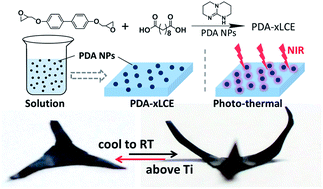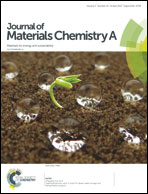Polydopamine nanoparticles doped in liquid crystal elastomers for producing dynamic 3D structures†
Abstract
Achieving 3D structures that can be reversibly formed from dry 2D polymer films is useful for the development of suitable smart materials capable of converting an external stimulus into a mechanical response. For the construction of dynamic 3D structures, carbon nanotubes dispersed in liquid crystalline vitrimers constitute so far one of the few available materials that can show robust reconfiguration, easy repair, and low-temperature resistance. However, the severe aggregation of carbon nanotubes causes defects in the materials formed and incurs additional costs. Here, we show that organic polydopamine (PDA) nanoparticles can well replace carbon nanotubes to make suitable liquid crystalline vitrimers for the construction of dynamic 3D structures. We were able to disperse the PDA nanoparticles homogenously into the polymer matrix without carrying out any surface modification and without using any dispersant or sonication, which are required procedures for dispersing almost all inorganic nanoparticles into a polymer matrix. Moreover, the mechanical properties of the liquid crystalline vitrimer were found to be greatly improved. Using this composite, we also showed here a new method to achieve light-controlled 3D deformation into static structures.



 Please wait while we load your content...
Please wait while we load your content...